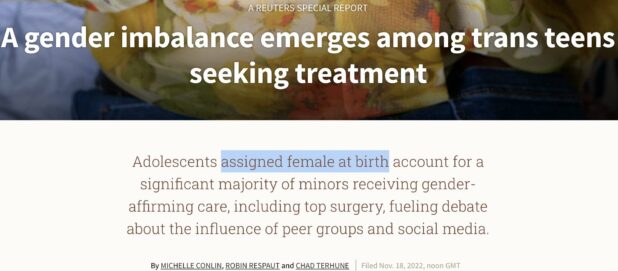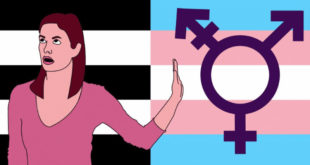Shouldn’t this be proof that women are oppressed?
If women are seeking to become men, it seems to me that they are not happy as women.
I don’t think the reason they are unhappy is oppression, but it sure seems to me that the media should be saying that.
A year after moving to Bridge City, Texas, 8-year-old Samuel Kulovitz thought his life couldn’t get any worse. He had made no friends in the swampy oil refinery town and spent most of his time in his family’s mobile home. He missed Florida and playing on the beach there with other children.
But life did get worse. He hit puberty. For Kulovitz, who was assigned female at birth, “growing into being a young woman horrified me,” he said. “I kept crying and crying, and I didn’t know why I didn’t like it.”
Then, at age 11, Kulovitz started venturing onto social media. There, he came across a cosplayer on Tumblr who said he realized he was a transgender boy from the euphoria he felt while dressed as the hero of an online comic. Kulovitz was transfixed. “I kept asking myself, ‘Why do you want to look like him?’” he told Reuters. In the online community where Kulovitz spent more and more time, he adopted the pronouns “he” and “him,” and he liked it.
When his mother learned of his transgender identity, she was supportive and enrolled him in therapy. He was diagnosed at age 12 with gender dysphoria, the distress that comes from identifying as a gender different from the one assigned at birth.
Two and a half years later, Kulovitz started on the hormone testosterone. He was thrilled as he grew facial and chest hair, his voice dropped, and his menstrual periods stopped.
Still, his breasts were a constant source of distress, and his body ached from wearing a chest binder. “I always thought, ‘I wish I could get rid of them,’ ” Kulovitz said.
One day during his junior year of high school, Kulovitz, then 16, was scrolling on his phone when the TikTok account of a Miami surgeon who offered to “yeet the teets” of young transgender people popped up. In videos with hip-hop music playing in the background, Dr Sidhbh Gallagher provided detailed information about top surgery to remove or modify breasts and displayed photos of her satisfied gender-diverse patients, most of them young people, with shirts off to show the results of the doctor’s work. “Come to Miami to see me and the rest of the De Titty Committee,” she said in one of the videos.
Six months later, in June 2021, Kulovitz was in Miami with his mother, who gave consent for her son’s surgery and paid $10,000 out of pocket for it. He also had the letters of support Gallagher required from his therapist and doctor. When Kulovitz woke up after the procedure, “I felt euphoric,” he said. “I finally felt right in my body.”
Thousands of children who, like Kulovitz, were assigned female at birth have sought gender-affirming care in recent years. And for reasons not well-understood, they significantly outnumber those assigned male at birth who seek treatment.
As Reuters reported in October, a growing number of the children receiving care at the 100-plus gender clinics across the United States are opting for medical interventions – puberty-blocking drugs, hormones and, less often, surgery. And they are doing so even though strong scientific evidence of the long-term safety and efficacy of these treatments for children is scant.
That has led to a split among gender-care specialists: those who urge caution to ensure that only adolescents deemed well-suited to treatment after thorough evaluation receive it, and those who believe that delays in treatment unnecessarily prolong a child’s distress and put them at risk of self-harm.
Related: Doctors Tell Parents Kids May Commit Suicide Unless They Go Full Tranny
The outsized proportion of adolescents seeking treatment to transition from female to male has sparked parallel concerns. Professionals in the gender-care community agree that treatment of all transgender children should be supportive and affirming. The question, for some, is whether peer groups and online media may be influencing some of these patients to pursue medical transition, with potentially irreversible side effects, at a time in their lives when their identities are often in flux.
Haha.
Yeah, maybe.
Women are so retarded.
Corey Basch, a professor of public health at William Paterson University in New Jersey who researches health communication and teens’ use of social media, said she fears that some adolescents are susceptible to making faulty self-diagnoses without adequate input from medical professionals. “Teens are so incredibly vulnerable to information overload and being pushed in one direction,” Basch said. “They could be lacking the analytical skills to question who is giving this advice and if their advice is valid.”
Adolescents assigned female at birth initiate transgender care 2.5 to 7.1 times more frequently than those assigned male at birth, according to the World Professional Association for Transgender Health (WPATH), a 4,000-member organization of medical, legal, academic and other professionals. Several clinics in the United States told Reuters that among their patients, the ratio was nearly 2-to-1, and similar phenomena have been documented in Europe, Canada and Australia.
Not all of these patients receive medical treatment. Their gender-affirming care may entail adopting a name and pronouns aligned with their gender identity. It may include counseling and therapy. But an increasing number are opting to take hormones and have top surgery.
In October, researchers at Vanderbilt University School of Medicine published a paper showing a 389% increase in gender-affirming chest surgeries performed nationally from 2016 to 2019 on patients under age 18. The total of 1,130 procedures during the period, nearly all of them for chest masculinization, represents a weighted estimate based on records from more than 2,000 U.S. medical facilities. Likewise, at least 776 chest masculinization surgeries were performed on patients ages 13 to 17 with a gender dysphoria diagnosis over the past three years, according to U.S. insurance claims analyzed for Reuters by health technology company Komodo Health Inc. This is probably an undercount because it does not include procedures paid for out of pocket.
The predominance of patients assigned female at birth is a reversal from the past. For years, when very few minors sought gender care, those assigned male at birth accounted for the majority. But about 15 years ago, that began to change as care became more accessible and the overall number of patients started climbing, according to studies and interviews with gender-care specialists.
For example, at Amsterdam University Medical Center’s gender clinic, a pioneer in adolescent gender care, the proportions flipped. From 1989 to 2005, 59% of its adolescent patients were assigned male at birth, the Dutch clinic reported in a 2015 study published in the Journal of Sexual Medicine. Since 2016, about 75% of the clinic’s patients have been youths who were assigned female at birth.
…
Advocates of transgender rights and clinicians who treat adolescents see nothing out of the ordinary in the trend. While transgender children face significant prejudice and threats of violence, they say, increasing social acceptance of transgender identity has encouraged more children to seek treatment. At the same time, this reasoning goes, society is generally less accepting of what it deems an effeminate boy than of a masculine girl, and the greater stigma that those assigned male at birth face may make them less likely to pursue treatment, reducing their share of the patient population.
These children may not necessarily identify as transgender, but more broadly as gender diverse. A growing list of terms reflects this diversity of gender identities: agender, nonbinary, gender fluid, polygender, demiboy and demigirl.
“There’s been an explosion in the gender-expansive model,” said Dr Michelle Forcier, a professor of pediatrics at Brown University’s Alpert Medical School who has specialized in the care of transgender and gender-diverse patients. “Folks may feel freer and safer to express and take on a more diverse identity because the social conversation has been put out there.” For these patients, she said, “the moral and ethical thing to do is to give them a list of options that might help them achieve their gender goals.”
But other gender-care providers and some parents are skeptical. In interviews with Reuters, they expressed worry that some adolescents assigned female at birth may be dealing with significant mental health issues in addition to questions about their gender identity, or may be seeking to transition as a refuge in a culture of internalized misogyny, body hatred and early sexualization of girls.
…
In recent years, young transgender people have enthusiastically embraced social media to tell their stories. On platforms such as TikTok and Instagram, young people receiving gender treatment regularly share with followers – sometimes numbering in the tens of thousands – details about taking medications and having surgery. Their presence is augmented by doctors who use social media to communicate directly with potential patients.
Many patients, like Kulovitz, and doctors who treat them say social media can be a source of helpful advice and information for minors questioning their gender identity and can reduce their isolation by connecting them to others with similar experiences.
But some prominent clinicians also say that along with those benefits, social media may lead some youths to mistake mental health problems or uncertainty about their identity for gender dysphoria.
In its new Standards of Care, published in September, WPATH acknowledged for the first time that “social influence” may impact an adolescent’s gender identity. The organization recommends that youths undergo an in-depth evaluation in part so that clinicians “can discern between a person’s gender identity that is marked and sustained and an identity that might be socially influenced,” according to Dr Eli Coleman, director of the University of Minnesota Medical School’s Institute for Sexual and Gender Health who oversaw the update of WPATH’s guidelines.
Some patients may see others touting huge improvements in their quality of life after transitioning, and so they think, “‘I’m having these same problems, and transitioning to a different gender will help me feel better,’” said Dr Laura Edwards-Leeper, a clinical psychologist in Oregon who specializes in treating transgender children. She was a co-author of WPATH’s new Standards of Care for adolescents.
Parents of 40 gender-diverse children told Reuters they were concerned that their children came out only after they hit puberty, often at the same time as their friends and after their use of social media had increased. For many, their worries were compounded when clinicians swiftly affirmed their childrens’ transgender identities and recommended medical intervention without fully assessing whether other potential underlying causes of distress were present.
It’s truly amazing that we’re even having this conversation about mutilating children. I’m shocked by it every day.
Eventually, someone is going to have to be held responsible for this.
My teenage life has been the culmination of excruciating pain, regret, and most importantly injustice. It is impossible for me to recoup what I have lost, but I will insure no child will be harmed at the hands of these liars and mutilators. I am suing these monsters. @pnjaban pic.twitter.com/i80VHvGXJn
— Chloe Cole ⭐️ (@ChoooCole) November 11, 2022
Teacher says she asks students for names and pronouns and is careful when communicating with parents so she doesn’t “out” a student.
A kid can be living a double life, identifying as transgender or non-binary only in school and it will purposefully kept a secret from parents. pic.twitter.com/rSS7zrCJtm
— Libs of TikTok (@libsoftiktok) November 17, 2022
 Daily Stormer The Most Censored Publication in History
Daily Stormer The Most Censored Publication in History



